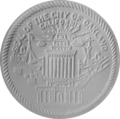AC Transit
 | |
 A collage of AC Transit's buses | |
| Founded | 1960 |
|---|---|
| Headquarters |
1600 Franklin St, Oakland, CA |
| Locale | East Bay |
| Service area | Western Alameda and Contra Costa Counties |
| Service type | bus service |
| Routes | 151[1] |
| Stops | approx. 5,500[2] |
| Fleet | 586[2] |
| Daily ridership |
approx. 178,851 ridership per year = approx. 55 million[2] |
| Operator | Alameda-Contra Costa Transit District |
| Chief executive | Mike Hursh, General Manager |
| Website | actransit.org |
AC Transit (Alameda-Contra Costa Transit District) is an Oakland-based public transit agency serving the western portions of Alameda and Contra Costa counties in the East Bay of the San Francisco Bay Area. AC Transit also operates "Transbay" routes across San Francisco Bay to San Francisco and selected areas in San Mateo and Santa Clara counties. AC Transit is constituted as a special district under California law. It is governed by seven elected members (five from geographic wards and two at large). It is not a part of or under the control of Alameda or Contra Costa counties or any local jurisdictions.
Buses operate out of three operating divisions: Emeryville, East Oakland (Seminary), and Hayward. The Operations Control Center is located in Emeryville.[2] The Richmond operating division closed in 2011,[3] but is open again due to a revived economy.[4] The District is the public successor to the privately owned Key System.
Service area
The District encompasses the following cities and unincorporated areas: Oakland, Fremont, Hayward, Berkeley, Richmond, San Leandro, Alameda, Castro Valley, Newark, San Pablo, El Cerrito, San Lorenzo, Ashland, Albany, Cherryland, El Sobrante, Piedmont, Fairview, Emeryville, Kensington, and East Richmond Heights. The District's bus lines also serve parts of some other East Bay communities, including Milpitas, Pinole, and Union City.
AC Transit serves many colleges and universities including the University of California, Berkeley; Stanford University; California State University, East Bay; Chabot College; Holy Names University; Peralta Colleges (Laney College, College of Alameda, Berkeley City College, and Merritt College), Contra Costa College; Ohlone College; Northwestern Polytechnic University; and Mills College.
Most routes connect with regional train service, primarily BART (Bay Area Rapid Transit), in addition to ACE and Amtrak, including (among other trains) the Capitol Corridor. AC Transit routes also connect with several other regional transit services, including Union City Transit, SamTrans, WestCAT, the Santa Clara Valley Transportation Authority (VTA), San Francisco Municipal Railway (Muni), Golden Gate Transit, the Alameda-Oakland Ferry, the Harbor Bay Ferry, Emery Go Round, SolTrans and FAST.
While most AC Transit service consists of local lines throughout the East Bay, the District also provides many Transbay lines. Most of these run across the San Francisco–Oakland Bay Bridge to connect communities as distant as El Sobrante and Newark with San Francisco's Transbay Terminal (formerly the terminus of the Key System). Bus service is also provided across the San Mateo and Dumbarton bridges to the south.
Hubs
AC Transit's primary hubs include BART stations, major shopping centers, and points of interest, which are spread throughout the East Bay. Most routes serve and/or terminate at BART stations, providing convenience for transit users. The hubs include:
Routes
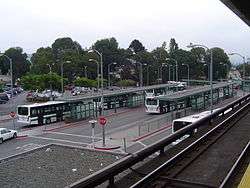
Timeline
Voters created the Alameda-Contra Costa Transit District (AC Transit) in 1956 and subsequently approved a $16,500,000 bond issue in 1959 enabling the District to buy out the failing privately owned Key System Transit Lines. In October 1960, AC Transit’s service began. The new District built up the bus fleet with 250 new “transit liner” buses, extended service into new neighborhoods, created an intercity express bus network, and increased Bay Bridge bus service.[5]
In 2003, the District introduced a San Mateo-Hayward Bridge route. Designated as Line M, the service connected the BART stations of Castro Valley and Hayward with Foster City and San Mateo's Hillsdale Caltrain station. A second San Mateo-Hayward Bridge route, Line MA, was added in 2006 and discontinued in 2007. (The M replaced the SamTrans 90E, which had been canceled in 1999.)
In 2003, a new "rapid bus" line operating on San Pablo Avenue was introduced. Designated as Line 72R (or San Pablo Rapid), the service connected Oakland with Richmond and operated at faster speeds than regular local service due to wide stop spacing and signal priority treatments.
In 2004, the District began service on Line U across the Dumbarton Bridge, connecting Stanford University with ACE and BART trains in Fremont. As part of a consortium of transit agencies including AC Transit, BART, SamTrans, Union City Transit, and VTA), the District already operated Dumbarton Express bus service across the Dumbarton Bridge.
Beginning 10 December 2005, AC Transit began participating in the regional All Nighter network, providing 24-hour bus service throughout its service area to supplement BART service, which does not operate during owl hours. AC Transit had provided 24-hour service on many of its trunk lines prior to this date, except in the late 1990s due to budget limitations.
On 30 July 2007, AC Transit announced that it had entered into a 25-year partnership with SunPower, MMA Renewable Ventures, and PG&E to install solar energy systems at its facilities in an effort to reduce its carbon footprint, improve local air quality, and save money on energy costs that could be used instead to spend on transit service.[6]
In 2008, AC Transit sponsored the world's largest chalk drawing at the old Alameda Naval Base and provided free transportation for children to the site.[7]
On 28 March 2010, several major service changes were implemented to reduce a severe budget shortfall. Changes included reduced service on local and Transbay lines, elimination of unproductive routes, splitting of the 51 into two sections, and the introduction of limited-stop line 58L.[8][9]
Starting in February 2011, all buses on Line 376 were being escorted by a marked Contra Costa County Sheriff's patrol vehicle through the unincorporated community of North Richmond. Line 376 provides late-night service through North Richmond and the nearby cities of Richmond, San Pablo, and Pinole. The escorts were introduced to improve the safety of the service, which had five serious incidents between 5 January and 9 February.[10]
On December 13, 2013, AC Transit adopted a new fare policy that brought changes to the transit system July 2014, including a new day pass that is in line with other transit agencies including VTA and SamTrans.[11] The policy is also designed to speed boarding and help keep buses on schedule, provide greater convenience and value for customers, and encourage more customers to switch to Clipper[12]
Rapid Bus and Bus Rapid Transit
Line 72R | |||||||||||||||||||||||||||||||||||||||||||||||||||||||||||||||||||||||||||||||||||||||||||||||||||||||||||||||||||||||||||||||||||||||||||||||||||||||||||||||||||||||||||||||||||||||||||||||||||||||||||||||||||||||||||||||||||||||||||||||||||||||||||||||||||||||||||||||||||||||||||||||||||||||||||||||||||||||||||||||||
|---|---|---|---|---|---|---|---|---|---|---|---|---|---|---|---|---|---|---|---|---|---|---|---|---|---|---|---|---|---|---|---|---|---|---|---|---|---|---|---|---|---|---|---|---|---|---|---|---|---|---|---|---|---|---|---|---|---|---|---|---|---|---|---|---|---|---|---|---|---|---|---|---|---|---|---|---|---|---|---|---|---|---|---|---|---|---|---|---|---|---|---|---|---|---|---|---|---|---|---|---|---|---|---|---|---|---|---|---|---|---|---|---|---|---|---|---|---|---|---|---|---|---|---|---|---|---|---|---|---|---|---|---|---|---|---|---|---|---|---|---|---|---|---|---|---|---|---|---|---|---|---|---|---|---|---|---|---|---|---|---|---|---|---|---|---|---|---|---|---|---|---|---|---|---|---|---|---|---|---|---|---|---|---|---|---|---|---|---|---|---|---|---|---|---|---|---|---|---|---|---|---|---|---|---|---|---|---|---|---|---|---|---|---|---|---|---|---|---|---|---|---|---|---|---|---|---|---|---|---|---|---|---|---|---|---|---|---|---|---|---|---|---|---|---|---|---|---|---|---|---|---|---|---|---|---|---|---|---|---|---|---|---|---|---|---|---|---|---|---|---|---|---|---|---|---|---|---|---|---|---|---|---|---|---|---|---|---|---|---|---|---|---|---|---|---|---|---|---|---|---|---|---|---|---|---|---|---|---|---|---|---|---|---|---|---|---|---|---|---|---|---|
| |||||||||||||||||||||||||||||||||||||||||||||||||||||||||||||||||||||||||||||||||||||||||||||||||||||||||||||||||||||||||||||||||||||||||||||||||||||||||||||||||||||||||||||||||||||||||||||||||||||||||||||||||||||||||||||||||||||||||||||||||||||||||||||||||||||||||||||||||||||||||||||||||||||||||||||||||||||||||||||||||
East Bay BRT | ||||||||||||||||||||||||||||||||||||||||||||||||||||||||||||||||||||||||||||||||||||||||||||||||||||||||||||||||||||||||||||||||||||||||||||||||||||||||||||||||||||||||||||||||||||||||||||||||||||||||||||||||||||||||||||||||||||||||||||||||||||||||||||||||||||||||||||||||||||||||||||||||||||||||||||||||||||||||||||||||||||||||||||||||||||||||||||||||||||||||||||||||||||||||||||
|---|---|---|---|---|---|---|---|---|---|---|---|---|---|---|---|---|---|---|---|---|---|---|---|---|---|---|---|---|---|---|---|---|---|---|---|---|---|---|---|---|---|---|---|---|---|---|---|---|---|---|---|---|---|---|---|---|---|---|---|---|---|---|---|---|---|---|---|---|---|---|---|---|---|---|---|---|---|---|---|---|---|---|---|---|---|---|---|---|---|---|---|---|---|---|---|---|---|---|---|---|---|---|---|---|---|---|---|---|---|---|---|---|---|---|---|---|---|---|---|---|---|---|---|---|---|---|---|---|---|---|---|---|---|---|---|---|---|---|---|---|---|---|---|---|---|---|---|---|---|---|---|---|---|---|---|---|---|---|---|---|---|---|---|---|---|---|---|---|---|---|---|---|---|---|---|---|---|---|---|---|---|---|---|---|---|---|---|---|---|---|---|---|---|---|---|---|---|---|---|---|---|---|---|---|---|---|---|---|---|---|---|---|---|---|---|---|---|---|---|---|---|---|---|---|---|---|---|---|---|---|---|---|---|---|---|---|---|---|---|---|---|---|---|---|---|---|---|---|---|---|---|---|---|---|---|---|---|---|---|---|---|---|---|---|---|---|---|---|---|---|---|---|---|---|---|---|---|---|---|---|---|---|---|---|---|---|---|---|---|---|---|---|---|---|---|---|---|---|---|---|---|---|---|---|---|---|---|---|---|---|---|---|---|---|---|---|---|---|---|---|---|---|---|---|---|---|---|---|---|---|---|---|---|---|---|---|---|---|---|---|---|---|---|---|---|---|---|---|---|---|---|---|---|---|---|---|---|---|---|---|---|---|---|---|---|---|---|---|---|---|---|---|---|---|---|---|---|---|---|---|
Not yet in operation | ||||||||||||||||||||||||||||||||||||||||||||||||||||||||||||||||||||||||||||||||||||||||||||||||||||||||||||||||||||||||||||||||||||||||||||||||||||||||||||||||||||||||||||||||||||||||||||||||||||||||||||||||||||||||||||||||||||||||||||||||||||||||||||||||||||||||||||||||||||||||||||||||||||||||||||||||||||||||||||||||||||||||||||||||||||||||||||||||||||||||||||||||||||||||||||
| ||||||||||||||||||||||||||||||||||||||||||||||||||||||||||||||||||||||||||||||||||||||||||||||||||||||||||||||||||||||||||||||||||||||||||||||||||||||||||||||||||||||||||||||||||||||||||||||||||||||||||||||||||||||||||||||||||||||||||||||||||||||||||||||||||||||||||||||||||||||||||||||||||||||||||||||||||||||||||||||||||||||||||||||||||||||||||||||||||||||||||||||||||||||||||||
A rapid bus line was introduced on San Pablo Avenue on 23 June 2003. Designated as Line 72R (or San Pablo Rapid), it operates from 6 am to 7 pm at 12-minute intervals on weekdays, and 7 am to 7 pm at 15-minute intervals on weekends and holidays. Bus stops are spaced 2/3-mile apart on average, running between Jack London Square (via 20th Street and Broadway) in Oakland and Contra Costa College in San Pablo, and buses receive signal priority at several intersections. Although the line does have scheduled timepoints en route, most buses typically travel along the route as fast (or as slow) as traffic allows.
A second rapid bus line was introduced on 24 June 2007.[13][14] Line 1R (or International Rapid) operated on weekdays between Berkeley Way and Oxford Street in Berkeley and Bay Fair BART station, mainly along Telegraph Avenue, International Boulevard, and East 14th Street. Weekend and holiday service operated between downtown Oakland and San Leandro only.
Line 1R was eliminated in 2016. AC Transit is currently constructing a Bus Rapid Transit line along International Blvd.[15] AC Transit’s East Bay Bus Rapid Transit (BRT) project will operate between uptown Oakland and San Leandro. Approved in 2012 by both cities, BRT will feature level boarding, pre-paid ticketing, and dedicated transit lanes along much of the corridor. The project is funded by Alameda County Measure B, the Metropolitan Transportation Commission, the State of California, and the Federal Transit Administration. The project broke ground in August 2016[16] and is expected to begin revenue service in late 2019.[17] There are no plans for bus rapid transit along the Telegraph Avenue alignment of the 1R; the section between uptown Oakland and U.C. Berkeley is mostly served by present-day local line 6.
Bus fleet
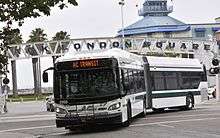
At its inception, AC Transit continued using GM "old-look" buses of its predecessor, which was the Key System. AC Transit soon ordered GM New Look buses and operated a mixed fleet throughout the 1960s. AC Transit pioneered the use of an articulated bus in the mid-1960s, operating the experimental GM XMC 77 bus primarily on Transbay service.[18]
AC Transit continued purchasing GM New Look buses through the early 1970s and also purchased Flxible New Look buses. Then, AC Transit began acquiring buses from Flyer, Neoplan, and Gillig through the 1980s. In the late 1990s, AC Transit added buses from NABI.[19] AC Transit supplemented these buses with a fleet of 45-foot over-the-road coaches purchased from Motor Coach Industries beginning in the early 2000s. In 2003, AC Transit began purchasing low-floor buses from Van Hool.
AC Transit has the most comprehensive fuel cell bus program in the United States.[20] Three hydrogen-powered buses, based on the Van Hool A330, operated in revenue service from 2006 to 2010. AC Transit took delivery of 12 third-generation fuel cell buses, based on the Van Hool A300L, in 2011.
In March 2013, AC Transit began operating the first of its new Gillig buses.[21] In August of the same year, AC Transit placed the first of its new New Flyer articulated buses into service.[22] And later that year, in November 2013, new Gillig buses with a suburban seating configuration and Transbay branding were introduced into service.[23]
All AC Transit buses are wheelchair accessible and have front-mounted bicycle racks. The MCI buses also feature luggage bay bicycle racks. AC Transit buses purchased after 2007 have air conditioning, as approved by the Board of Directors.[24]
| Year | Manufacturer | Model | Length (feet) | Quantity | Fleet Series | Fuel Propulsion | Powertrain | Image |
|---|---|---|---|---|---|---|---|---|
| 2000 | MCI | D4500 | 45 | 5 | 6001-6030 | Diesel |
|
|
| 2001 | MCI | D4500 | 45 | 2 | 6031-6040 | Diesel |
|
|
| 2003 | MCI | D4500 | 45 | 39 | 6041-6079 | Diesel |
|
|
| Van Hool | A330 | 40 | 98 | 1001-1110 |
|
|||
| AG300 | 60 (articulated) | 30 | 2001-2057 |
|
||||
| 2006 | Van Hool | A300K | 30 | 51 | 5001-5051 | Diesel |
|
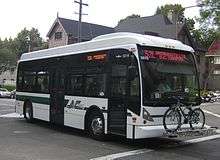 |
| 2007 | Van Hool | AG300 | 60 | 10 | 2101-2110 | Diesel |
|
|
| 60 | 14 | 2151-2165 |
|
|||||
| 2008 | Van Hool | A300L | 40 | 27 | 1201-1227 | Diesel |
|
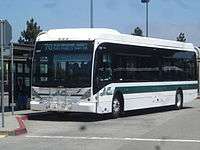 |
| A300K | 30 | 39 | 5101-5139 | Diesel |
|
|||
| 2010 | Van Hool | AG300 | 60 | 9 | 2191-2199 | Diesel |
|
|
| A300L FC | 40 | 12 | FC4-FC16 | Hydrogen | ||||
| 2013 | Gillig | Low Floor | 40[25] | 65 | 1301-1365 | Diesel |
|
|
| New Flyer | Xcelsior XD60 | 60 (articulated)[22] | 23 | 2201-2223 | Diesel |
|
||
| Gillig | Low Floor | 40[27] | 54 | 6101-6155 | Diesel |
|
.png) | |
| 2014 | Gillig | Low Floor | 40 | 68 | 1401-1468 | Diesel |
|
|
| 2015 | ElDorado National | Aerotech 220 | 24 | 10 | 3501-3510 | Diesel |
|
 |
| 2016 | Gillig | Low Floor | 40 | 55 | 1501-1555 | Diesel |
|
|
| 2016 | Gillig | Low Floor[28] | 40 | 25 | 1556-1580 | Diesel-Electric Hybrid | ||
| 2017 | Gillig | Low Floor | 40 | 10 | 1581-1590 | Diesel |
Funding
AC Transit is funded with a mix of federal, state, and local government subsidies, as well as passenger fares.
In March 2004, voters throughout the San Francisco Bay Area approved Regional Measure 2, which funds regional transportation capital and operating programs through a US$1.00 surcharge on State-owned bridges operated by the BATA. (The Golden Gate Bridge is owned and operated by the Golden Gate Bridge, Highway and Transportation District.)[29]
In November 2004, voters approved Measure BB, which increased the parcel tax from US $24 to US$48 annually for 10 years beginning 1 July 2005, to help fund AC Transit services.[30]
In April 2005, a federal class-action lawsuit was filed against the Metropolitan Transportation Commission alleging that it discriminates against AC Transit's primarily minority riders by giving AC Transit disproportionately less money than BART and Caltrain. AC Transit is not party to the lawsuit, and the court sided with MTC in 2009.[31]
In November 2008, voters approved Measure VV, which increased the parcel tax by US$48 annually for 10 years beginning 1 July 2009, to help fund AC Transit services. Measure VV also extended the US$48 parcel tax approved under Measure BB so a total US$96 annual tax is effective through 30 June 2019.[32]
Internet access
AC Transit also offers wireless internet on many buses that serve Transbay lines.[33] These buses can be distinguished by their all-green livery, padded "commuter" seats, and Wi-Fi logos near the front entrance door and inside the bus.
References
- ↑ AC Transit Bus Line Descriptions
- 1 2 3 4 5 Ridership, Bus Fleet and Service
- ↑ AC Transit cuts costs to balance budget
- ↑
- ↑ History of AC Transit
- ↑ AC Transit Turns on Solar Power Archived October 28, 2007, at the Wayback Machine., AC Transit External Affairs, 30 July 2007, retrieved 31 July 2007
- ↑ AC Transit Sponsors World's Largest Chalk Drawing Archived July 22, 2008, at the Wayback Machine., AC Transit External Affairs, 9 June 2008, accessed 21 July 2008
- ↑ Service Changes Set for March 28
- ↑ Detailed List of Service Changes Archived March 14, 2010, at the Wayback Machine.
- ↑ North Richmond bus line gets police escort. Ted Trautman. Richmond Confidential. 24-02-2011. Retrieved 06-03-2011.
- ↑ Board Adopts New & Improved Fare Policy. AC Transit. 13 December 2013. Retrieved 8 February 2014.
- ↑ New Day Pass & Other Fare Policy Changes Coming in July
- ↑ "Marketing & Community Relations Priorities Through December 2006," memo to AC Transit Board of Directors, 19 April 2006 Archived August 11, 2007, at the Wayback Machine.
- ↑ "Change Happens: June 24," AC Transit Marketing, 15 May 2007 Archived November 1, 2007, at the Wayback Machine.
- ↑ About BRT
- ↑ AC Transit Announces the Groundbreaking Ceremony for the East Bay Bus Rapid Transit
- ↑ Wirtschafter, Eli (18 April 2018). "Hey Area: What help is there for Oakland businesses impacted by bus rapid transit?". KALW. Retrieved 15 May 2018.
- ↑ Photo of AC Transit XMC 77 at the Transbay Terminal in San Francisco, California, circa 1965 Archived 23 August 2011 at the Wayback Machine.
- ↑ AC Transit GM Memo 06-864 Revised
- ↑ The HyRoad
- ↑ New Gillig Buses Start Service March 28
- 1 2 The New Flyers Are Here!
- ↑ New Commuter Buses Launched
- ↑ Installation of air conditioning on buses
- ↑ A Better Ride on AC Transit’s Newest Buses
- 1 2 3 Fleet Specifications
- ↑ New Commuter Buses Launch November 8
- ↑ "AC Transit announces the launch of AC Go". AC Transit. 24 June 2016.
- ↑ MTC.ca.gov
- ↑ Smartvoter.org
- ↑ SF.streetsblog.org
- ↑ Smartvoter.org
- ↑ The Daily Californian Archived April 9, 2007, at the Wayback Machine.
External links
| Wikimedia Commons has media related to AC Transit. |
